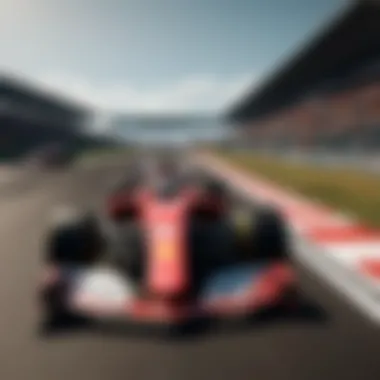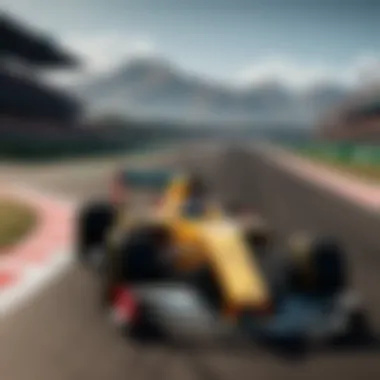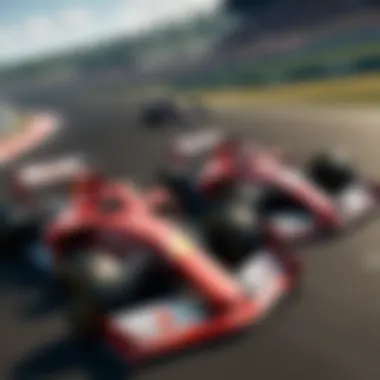The Digital Transformation of Formula 1 Racing


Intro
Formula 1 has evolved dramatically in recent years, not merely as a sport but as a complex interplay of technology, strategy, and global engagement. From the roaring engines that once defined the race experience to the silent undercurrents of data analysis and digital interaction, we find ourselves navigating a new era. The previously simple task of racing has morphed into a multi-faceted operation, where every lap is influenced by real-time data, social media in addition to daredevil driving.
In exploring the digital transformation of Formula 1, this article will delve into several crucial junctions of change. It will investigate how digital tools have reshaped the race strategies teams employ; it will examine the intricate relationship between fans and racing through various online platforms, and it will provide insights into how these shifts have redefined the competition and the overall landscape of motorsport.
The Digital Landscape of Racing
Drivers are not just pushing cars to the limit; they are weaving through a digital tapestry that dictates their performance and engagement with fans. Teams utilize advanced algorithms coupled with cloud computing to analyze vast amounts of data. This creates strategies that are not just about speed, but timing, tire wear, and even weather conditions. Every second counts, and an understanding of the digital landscape can mean the difference between a podium finish and going home empty-handed.
In the realm of fan engagement, the conversation has widened significantly thanks to social media and streaming platforms. Social media offers fans an insider's view into teams and drivers, breaking down barriers that once stood tall between the track and the viewers at home. The insights shared on platforms like Facebook or Reddit foster a global community of enthusiasts hunting for the most immediate gossip, race reviews, or driver antics.
Change is the only constant, they say. And as we look to the future, one can only ponder the next wave of digital innovation that is set to sweep across Formula 1. From immersive virtual reality experiences to sophisticated simulations that can predict the outcome of races, the implications for the sport itself are both exciting and daunting.
"In Formula 1, technology is no longer a luxury; it's a necessity to remain competitive in a landscape that is perpetually evolving."
Join us as we dissect these facets of change and navigate the nuances of how digital evolution continues to shape the very essence of Formula 1 racing.
The Historical Context of Formula Racing
When navigating the intricate landscape of Formula 1, one cannot overlook the vital role of its historical context. Understanding the journey that has led us to today's high-tech racing spectacle unveils the formative experiences that shaped not only the sport but also the very technologies that we see on the track. In this exploration, we will dissect how the past informs our present and future as F1 blends time-honored traditions with digital advancements.
Origins of Formula
The roots of Formula 1 can be traced back to the early 20th century, a time when automobile racing was still finding its feet. The inaugural World Championship of Drivers, held in 1950, is considered the birth of Formula 1 as we know it today. It was a melding of a rich history of motorsport and structured competition, showcasing not just speed but also engineering prowess.
The significance of races held during this formative time can't be understated. As different countries held their own grand prix events, they contributed to an ever-evolving set of regulations and standards. Many innovations like the introduction of the rear-engine layout came about as teams aimed to improve aerodynamics and handling, which, in turn, changed the way races were conducted and won.
These early years set a precedent for the ever-increasing emphasis on not just performance but also safety and reliability. With talented drivers like Juan Manuel Fangio paving the way, a culture developed around both camaraderie and fierce competition, fueling the engines of progress that led to future technological advancements.
Milestones in Racing Technology
Throughout the decades, certain breakthroughs emerged as game changers, facilitating significant shifts in how Formula 1 races were run, and designed.
- Aerodynamic Design: From the initial use of simple spoilers in the 1960s to the sophisticated wind tunnels of today, aerodynamics remains a cornerstone of F1 innovation. Cars transformed from mere machines to streamlined wonders, enabling unparalleled speed.
- Electronic Systems: The introduction of electronic timing and telemetry in the 1980s brought a seismic shift. Teams could now gather data in real-time, making strategic moves based on comprehensive analytics, rather than gut feeling or intuition alone.
- Safety Features: Notably, the tragic loss of Ayrton Senna in 1994 led to a heightened focus on driver safety. The implementation of crash structures, head and neck safety devices, and the halo cockpit protection system have redefined the priorities of racing engineers.
These milestones have not just altered the mechanics of racing but also the viewer experience. The ever-changing technological landscape has made Formula 1 a living tapestry of innovation, demanding not just speed and skill from drivers, but also strategic acumen to navigate the complexities introduced by these advancements.
As we move deeper into the exploration of digital evolution, it is crucial to appreciate how our current understanding has been shaped by these historical advancements. The past is more than a prelude; it’s an active ingredient in the recipe for future successes.
Defining Digital Evolution
In recent years, the term digital evolution has come to encapsulate a significant shift within industries, including the high-octane realm of Formula 1 racing. This evolution isn't merely a series of technological upgrades but rather a holistic transformation that affects every facet of the sport—from on-track strategies to fan interactions and business models. Understanding digital evolution in Formula 1 is crucial because it reveals how the sport adapts to a fast-changing digital landscape, harnessing technology to enhance performance and audience engagement.


What Digital Evolution Represents
At its core, digital evolution signifies the progressive integration of digital technologies in Formula 1. This includes using advanced analytics, real-time data communication, and simulation technologies that empower teams to make swift decisions on race day. Think of it this way: before the digital age, teams relied heavily on gut instincts and antiquated tools. Today, they’re equipped with a wealth of information. Data is the new fuel driving performance—every lap, every tire choice, and every pit stop is informed by meticulous analysis of mountains of data.
Moreover, this evolution goes beyond just the mechanics of racing. It also heavily influences fan engagement, which has become a priority in the highly competitive sports market. Through digital platforms, teams can connect with audiences like never before. It’s a two-way street where fans don’t just watch from the sidelines; they interact, share, and participate in the experience actively.
Key Drivers of Change
Several key drivers have sparked this digital evolution in Formula 1, including:
- Data Analytics: Teams now employ sophisticated analytics software to decode performance and strategy. Every decision is data-driven, maximizing efficiency at every turn—a fundamental departure from traditional methods.
- Social Media Platforms: Platforms such as Facebook and Twitter have become essential tools for interaction between fans and teams. The digital voice of the sport is often noted through social media, which has upgraded fan engagement dramatically.
- Enhanced Broadcasting Technologies: The way races are broadcast has evolved with more angles and insights available to viewers than ever, contributing to a richer spectator experience. Fans can access real-time stats and telemetry data while watching the race unfold.
- Emerging Technologies: Technologies like AI and machine learning are taking the digital evolution further. They facilitate everything from predictive modeling for race outcomes to enhancing the understanding of rival strategies.
To sum it up, digital evolution in Formula 1 represents a comprehensive rethinking of how the sport is conducted and experienced. It sets a foundation that hints at an exciting future for racing, where both competitors and fans play increasingly interactive roles in the spectacle of speed.
Technological Innovations in F1
The realm of Formula 1 has long been synonymous with cutting-edge technology. The innovations that have emerged over the years often serve not just to enhance the thrilling spectacle of racing, but also to redefine the very nature of the sport itself. Technology in F1 is not merely a set of tools; it is a catalyst for change that has significant implications for race strategies, vehicle performance, and fan interaction.
Impact of Data Analytics
Data analytics is arguably the backbone of contemporary Formula 1 racing. It involves collecting vast amounts of data throughout the race — from tire wear and fuel consumption to driver performance metrics and aerodynamic efficiency. Teams like Mercedes and Ferrari utilize advanced algorithms to weave together these strands of information, informing their race strategies in real time.
The crux of the effectiveness lies in predicting outcomes and making informed decisions. For instance, team strategists analyze data to decide the optimal time for pit stops. A well-timed pit can be the difference between victory and defeat, making the role of data analytics indispensable.
- Real-Time Decision Making: Instant data processing allows teams to react swiftly to shifts in race conditions.
- Enhanced Performance Analysis: Post-race analysis helps in refining strategies and improving vehicle design.
"In Formula 1, every lap can change the race's dynamics, and data is the guiding star that illuminates the best path forward."
The Role of AI in Race Strategies
Artificial Intelligence introduces a new layer of sophistication into race strategies. Utilizing machine learning, AI systems can predict outcomes based on historical data and current race conditions. For instance, by simulating various race scenarios, AI helps teams evaluate the most advantageous strategies tailored to their driver and vehicle capabilities.
While AI aids strategy, it is also a double-edged sword. Over-reliance on algorithms can lead to mechanical blind spots where human instinct and experience might offer crucial insights. Teams must therefore find a balance, integrating AI into their processes while ensuring that seasoned strategists are still at the helm when split-second decisions must be made under pressure.
- Scenario Simulation: Teams can run complex simulations to prepare for various race conditions.
- Driver Performance Optimization: AI helps tailor training regimens and improve driving technique based on data analysis.
Telematics and Real-Time Data Sharing
Telematics represents a significant leap in how information is exchanged in real-time during races. Sensors installed in cars generate a plethora of data points, which teams can access instantly. The telemetry not only conveys vehicle health indicators, such as engine performance and tire temperature, but also driver inputs like throttle position and braking intensity.
The key benefit of telematics is that it allows teams to monitor and adjust parameters even while the race is ongoing. For example, if a driver encounters unexpected handling issues, the engineering team can make adjustments to the car’s setup via digital communication. This interconnectedness transforms the pit-to-car relationship, enhancing operational efficiency in ways previously unimaginable.
- Live Monitoring: Continuous oversight improves responsiveness to technical challenges during the race.
- Data-Driven Adjustments: Teams can make informed mid-race alterations to car settings for optimal performance.
The interplay of data analytics, AI, and telematics highlights a profound shift in Formula 1—not just how races are won, but how they are understood and appreciated by audiences around the world.


Fan Engagement through Digital Platforms
In the age of rapid digital adaptation, Formula 1 racing finds itself at a pivotal juncture where fan engagement has taken on new forms and meaningful interactions have become paramount. As the sport incorporates advanced technologies, it enhances the way fans connect with their favorite teams and drivers. Digital platforms serve as powerful conduits, bridging the gap between the high-speed world of racing and the enthusiastic supporters following every twist and turn.
Social Media as a Communication Tool
Social media has emerged as a cornerstone for communication in Formula 1. Fans can now follow live updates on platforms like Twitter, Instagram, and Facebook, creating a constant cycle of interaction and engagement. Real-time posts allow fans to feel as if they are part of the action, experiencing the thrills of race day as though they are mere feet away from the pit lane.
Fans utilize social media to share opinions, discuss strategies, and even express their emotions during race weekends. The immediacy of this platform has cultivated a sense of community. For instance, hashtags create online conversations that can spark debates, attract followers, and even launch viral trends. As they clap back to elements of team performance or comment on race incidents, fans become not just observers but influential voices in the Formula 1 narrative.
Interactive Experiences via Apps
Mobile applications offer yet another layer of fan engagement, providing a tailored experience that brings followers closer to the sport. Official Formula 1 apps give fans features like live timing, race highlights, and up-to-the-minute news.
These apps go beyond mere updates; they allow fans to create their own live experiences. Users can select specific drivers to get tailored analytics and metrics that paint a fuller picture of what’s unfolding on the track. They can predict race outcomes, organize viewing parties, and even play interactive games linked to races to keep the fan spirit alive.
Moreover, the use of gamification techniques in these applications encourages fans to engage more deeply with the content. Fans can earn points and badges, fostering a competitive atmosphere even among the fan base itself.
Virtual Reality and Augmented Reality Applications
Virtual reality and augmented reality have revolutionized how fans experience Formula 1 racing. These technologies enable a transformative, immersive experience, allowing fans to enter the car and feel the thrill of a race from the driver’s perspective.
For instance, several F1 experiences now incorporate AR to let fans view cars and circuits in their living rooms, understanding mechanics and strategies in a way that textbooks simply can't convey. The potential for AR to enhance user experience during a race is vast; imagine pointing a smartphone at a circuit layout and instantly pulling crucial data about past laps, driver performances, and tire choices.
Additionally, these technologies can aid in generating interest among potential new fans. Experiences that offer immersion in the sport can draw in an audience that may not have previously engaged with racing.
"With the advent of these technologies, we're not just watching races; we’re living them. Virtual reality allows fans to step inside the cockpit, creating memories that are simply unattainable through traditional viewing methods."
The Economics of Digital Transformation
In the world of Formula 1, digital transformation isn’t just a buzzword; it’s a fundamental shift that affects how teams operate and how they connect with their audience. The economics related to this transformation play a pivotal role in determining the sport’s sustainability and profitability in a fast-evolving digital landscape.
Sponsorships and Brand Partnerships
With the advent of digital technologies, sponsorships have evolved beyond traditional trackside branding. Companies are now looking to align their brands with digital-first strategies, recognizing that fans want engagement in their own terms. This shift has given rise to more dynamic partnerships.
- Enhanced Visibility: Digital initiatives allow sponsors to reach fans across multiple platforms. For example, through live streaming and social media interaction, brands gain exposure that extends far beyond race weekends.
- Data-Driven Decisions: Teams can provide sponsors with detailed analytics on viewer engagement and interaction metrics, which are invaluable for tailoring marketing campaigns.
- Customized Experiences: Brands can co-create digital content that resonates with fans. A partnership between a team and a tech company could lead to augmented reality experiences during races, where fans can see real-time stats overlaid onto their favorite cars.
- Flexibility in Engagement: Unlike traditional sponsorships, digital ones can be adjusted in real-time. If a brand sees low engagement on a certain platform, they can pivot their strategy quickly without incurring heavy costs.
The result is a win-win where brands find value in authentic fan engagement and teams benefit from increased revenue streams.
The Financial Impact of Enhanced Audience Metrics
The rise of digital technology has also brought about advanced metrics that can substantially influence the bottom line in Formula 1. These metrics, derived from digital platforms, are a treasure trove of information that teams and sponsors can harness effectively.
"In a world increasingly driven by data, the teams that embrace this shift stand to gain a significant edge."


- Targeted Marketing: Companies can target their advertising based on detailed audience analytics. Knowing when and where fans engage allows for better-placement of ads, leading to higher conversion rates.
- Revenue Generation: Accurate metrics allow teams to showcase their value to potential sponsors more convincingly. Clear data on fan demographics and engagement can translate into more lucrative sponsorship deals.
- Investment in Technology: As teams tap into these metrics, they foster a culture of innovation. The financial clout garnered from digital sponsorships can be reinvested into newer technologies and better race strategies.
- Real-time Financial Insights: Teams can monitor their digital revenues and engagement metrics live, enabling better financial planning and strategy realignment throughout the season.
The comprehensive analysis of audience metrics thus not only augments revenue but also fosters a robust ecosystem where data and technology play key roles in decision-making within the sport.
Challenges and Criticisms of Digital Integration
As Formula 1 embraces the digital age, it faces a series of challenges and criticisms that warrant careful examination. The integration of cutting-edge technology transforms every facet of racing, but it’s not all sunshine and rainbows. This section aims to unpack the specific hurdles that the sport confronts in its digital evolution, alongside the potential pitfalls that come with these advancements.
Data Privacy Concerns
In today's hyper-connected world, data privacy is at the forefront of many discussions, and Formula 1 is no exception. With the collection of vast amounts of data—from telemetry to fan interactions—comes the responsibility of protecting that information. Teams and organizations are privy to sensitive details that, if mishandled, could lead to serious consequences.
Consider this: a racing team gathers comprehensive analytics not only about their cars and performance but also from their fans and followers. Their engagement on social platforms like Facebook can reveal personal preferences and interests. However, when there’s talk of selling or sharing that data without consent, eyebrows are raised, and trust can erode quickly.
The question of how securely teams manage this information is paramount. Are they implementing robust security measures? Are they fully compliant with data protection regulations like GDPR? These are critical questions that stakeholders must grapple with to safeguard their data from breaches and misuse.
"Protecting data isn’t just a precaution; it’s a necessity in maintaining the integrity of Formula 1 as we transmit and share information at lighting speed."
The Risk of Over-Reliance on Technology
Another pertinent challenge lies in the risk of over-reliance on technology. With all the fancy gadgets and software, it’s easy for teams to become overly dependent on digital tools. Engineers find themselves turning to complex algorithms and AI-driven models to steer race strategies. While this can bring about greater efficiency and potentially lucrative outcomes, there’s a flipside.
One significant concern is that human intuition and expertise might take a backseat to computer-generated suggestions. Racing historically thrives on the unpredictable; the art of responding to real-time situations is part of what makes it exhilarating. If the balance tips too heavily towards relying on machines, we may witness a scenario where decisions hinge more on logic than gut feeling.
Moreover, if teams encounter technical glitches or failures in their systems, the ramifications could be profound. Picture a scenario during a critical race where AI predicts tire strategies but falters; the resulting chaos could impact not only the race outcome but also team morale.
In summary, while the integration of advanced technology offers numerous benefits, an over-reliance poses its own set of risks, challenging the very essence of what makes Formula 1 not just a sport, but an engaging spectacle. Balancing the use of technology with human experience is essential for maintaining competitive integrity.
Future Directions in Formula
The landscape of Formula 1 is rapidly evolving, and understanding future directions is crucial. As the sport navigates through technological advancements and changing audience expectations, it also faces unique challenges that could reshape its very foundation. The future of Formula 1 is intricately tied to how digital solutions will be embraced and integrated. It’s a domain filled with opportunities, where innovation catalyzes not just the cars on the track, but also the entire fan experience.
Emerging Technologies on the Horizon
Emerging technologies are poised to redefine how teams operate and engage with fans. Not so long ago, tools like predictive analytics and telematics shaped race strategies. Now, advancements in areas like machine learning and decentralized computing are taking center stage.
- Data-Driven Insights: Teams are leveraging vast amounts of data collected during races to refine strategies with a precision that would astound even the most seasoned analysts. The ability to predict tire performance based on real-time data can mean the difference between winning and losing.
- Next-Gen Simulation Tools: Enhanced simulation technology enables drivers to practice in environments that mimic real-world conditions nearly perfectly. These products often use virtual reality, offering drivers the chance to experience tracks beforehand and familiarize themselves with each curve and elevation.
As we look ahead, F1 teams constantly scan the horizon for tools that can provide a competitive edge, whether through better performance analysis or enhanced fan interaction. The synergy between technology and racing is becoming stronger, making it a thrilling era for motorsport enthusiasts.
Sustainability and Digital Solutions
Sustainability now stands at the forefront of many industries, and Formula 1 is no exception. The digital revolution paves the way for significant strides in how the sport addresses its environmental footprint.
- Alternative Fuels and Renewable Energy: With the increasing push toward greener technologies, Formula 1 has begun experimenting with alternative fuels. The focus is not just on performance but also on minimizing emissions. Teams are exploring hybrid engines and fuels that promote sustainability without sacrificing speed.
- Energy Efficiency: Digital solutions can monitor energy consumption during races, thus reducing waste and promoting the use of energy-efficient technologies across all levels of the sport.
"Adaptation is not just a choice; it is imperative for survival in the modern motorsport landscape."
Fans today are increasingly aware of sustainability issues, and they gravitate towards brands that share their values. By integrating sustainability into their core practices, Formula 1 can not only draw in a more environmentally conscious audience but also set a benchmark for other sports. The future is bright, not just on the track but also in how the sport aligns itself with global efforts to promote sustainable practices.
Digital transformation and sustainability, when woven together, can redefine the very essence of Formula 1, ensuring longevity for both the sport and its loyal fans.















